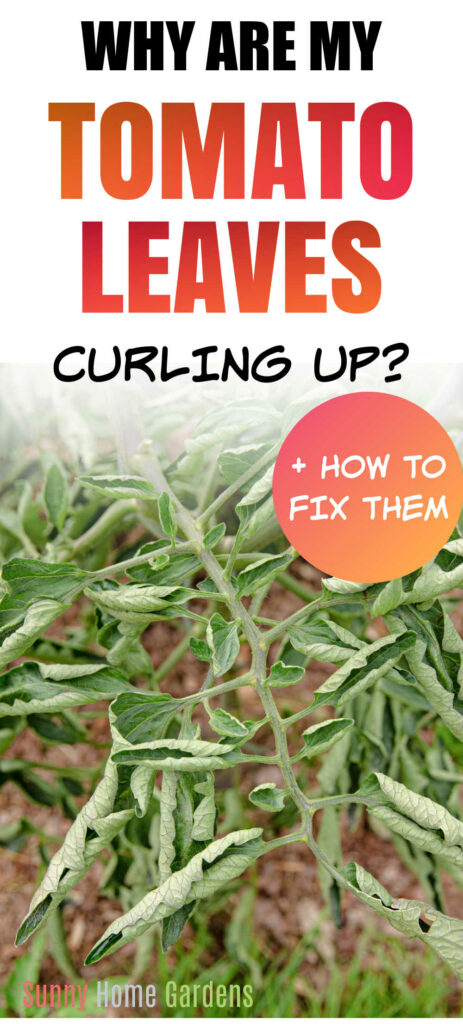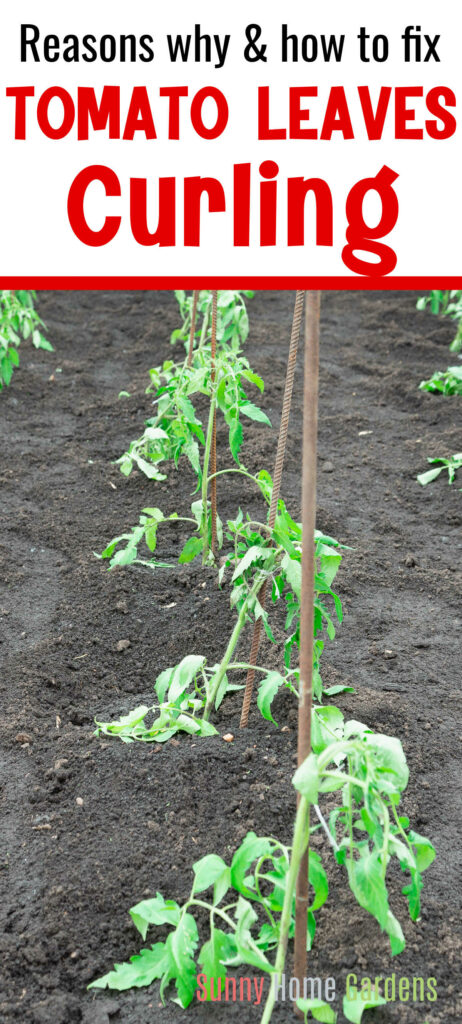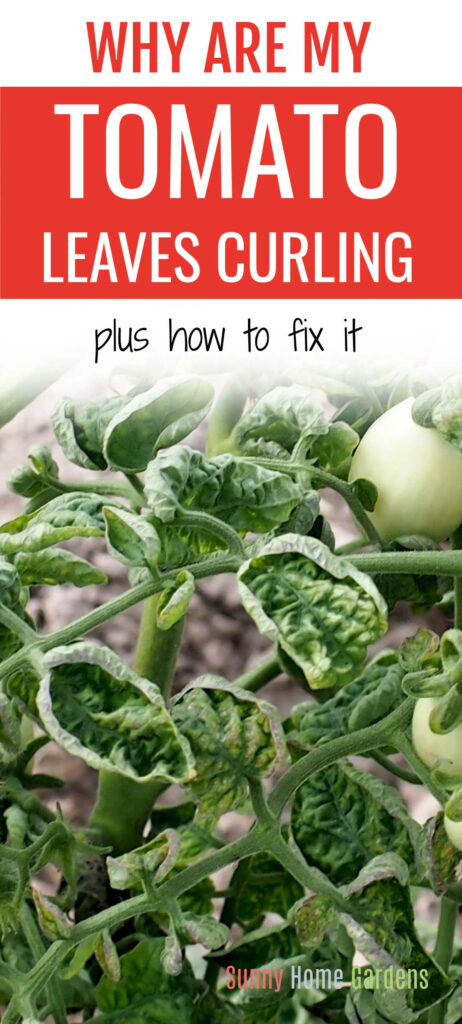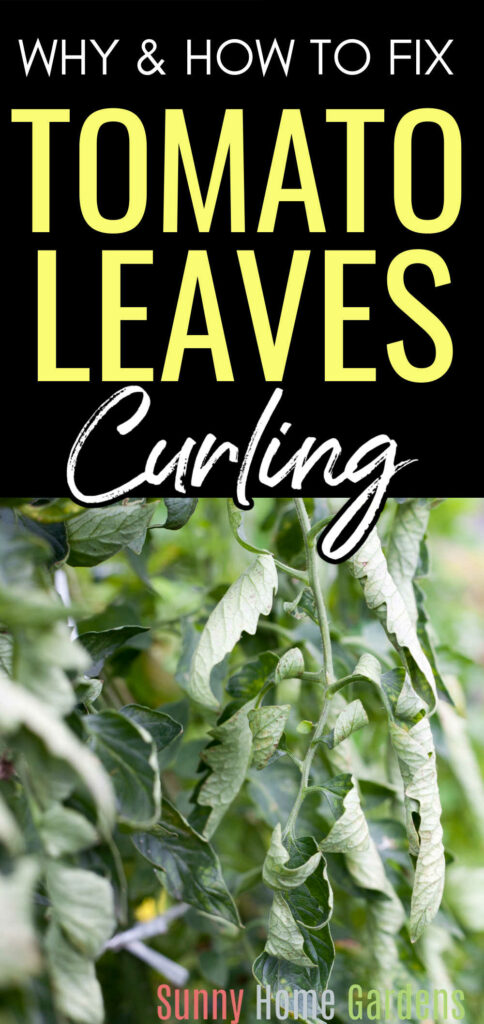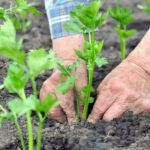If you’re wondering “why are my tomato leaves curling“, check out the reasons and how to fix this below.
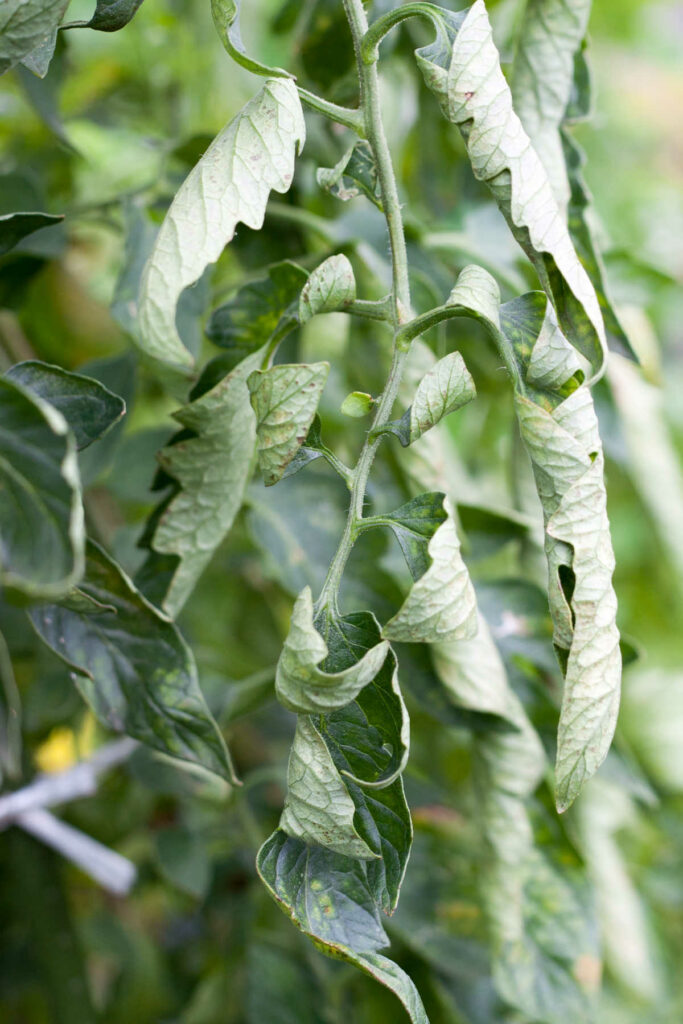
Tomatoes are one of the most popular vegetables grown. Whether you just started gardening or you’ve been at it for years, chances are you have some kind of tomatoes growing in your garden.
But why do so many people love to grow this crop? If I had to guess, it’s because tomatoes are one of the most versatile vegetables used in cooking.
Whatever your reason for growing tomatoes, you need to be aware of the challenges you may face when growing them. Just like all plants, you’re going to run into problems when growing tomatoes. Weather, pests, or diseases could cause these issues.
But the problem many gardeners run into, and the one we’re talking about today, is the curling of your tomato leaves.
Tomato plant leaves curl for many reasons, so there’s no need to panic if you notice this happening to your plants.
Most of the time, tomatoes will respond this way because they are under stress. Which is usually easy to manage, but even though the curling of your tomato leaves is not usually a threat, it’s not something that shouldn’t be ignored.
If left unattended, you could end up with a poor harvest, or even worse, your plant could die, and that’s the last thing you want.
To ensure that doesn’t happen to you, you need to know the top 5 Reasons Your Tomato Leaves Are Curling & How To Fix Them.
Table of Contents
Exposure To Herbicide
Exposure to an herbicide is not a common threat to your garden unless you’re using it yourself.
Even though it’s unlikely to wreak havoc on your plant and garden, it can still affect your tomato plants if you’re not careful.
The reason you don’t want this anywhere near your garden is that when nearby crops or weeds are sprayed with it, the wind can carry the spray to your tomato plants.
Once the herbicide gets to your tomato plant, it can often cause the leaves to curl down and wrap around the plant’s stem.
However, the new growth is more likely to be affected by the herbicides than the older leaves. But as long as you don’t live near a garden that uses it and you don’t use it, you have nothing to worry about.
But if your tomatoes do get exposed to herbicides, specifically 2 4-D and dicamba, there is no way to treat it. However, your tomatoes still have a chance if they were only slightly exposed.
If so, your plant has a high probability of being saved, but the fruit production can still be affected.
If your tomato plant is exposed to a higher amount, chances are you’ll need to dig up and dispose of your plant(s).
Too Hot
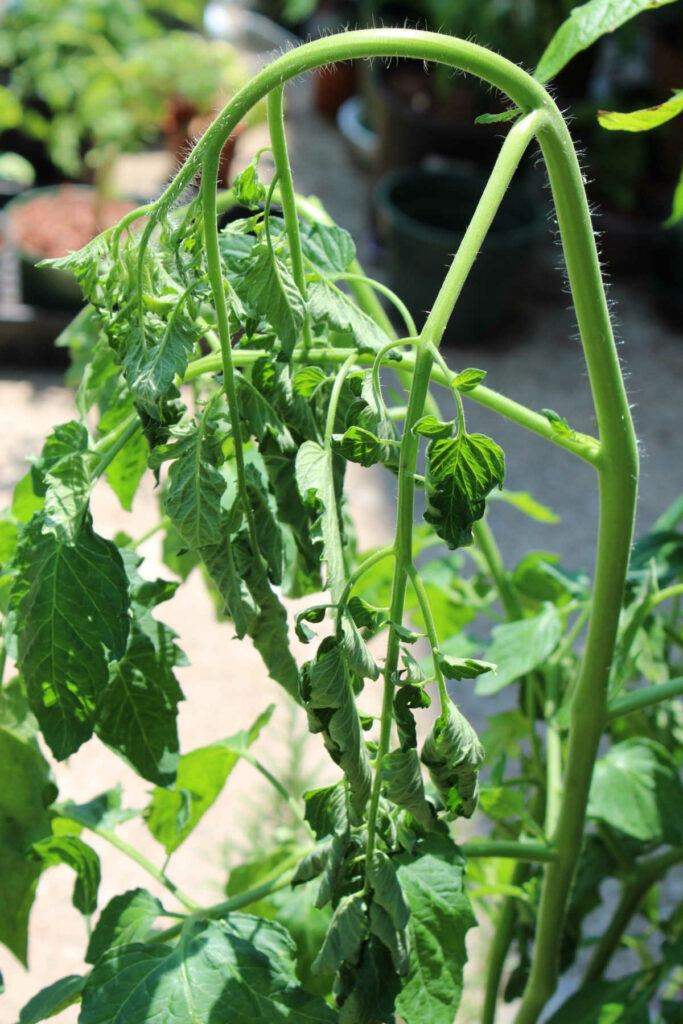
Heat exhaustion is one of the most common reasons your tomato leaves curl.
Even though tomato plants thrive in full sun, they do have a limit to the amount of heat they can take, just like any other plant.
When the temperature stays high for long periods of time, your tomato plant will start to stress. And nobody wants a stressed-out plant.
You can tell your plant is suffering from the heat when the leaves are curled into themselves.
The reason your tomato plant responds this way is that the plant is trying to preserve any water it has left.
Another way to tell if heat is causing your tomato leaves to curl, is wait for the sun to go down and see if the leaves bounce back. If they do then you’ll know they are being stressed out by the heat and can use the following to help.
One way to combat this is by watering more frequently and providing shade during the hottest hours of the day. Using a shade cloth or net is a good solution for this.
If you planted your tomatoes in a movable container, you could move the planter to a shady spot during the heat of the day.
After you apply these methods, you’ll notice a change in your tomato plants. This should not affect the production of fruit.
Transplanting Of Any Kind
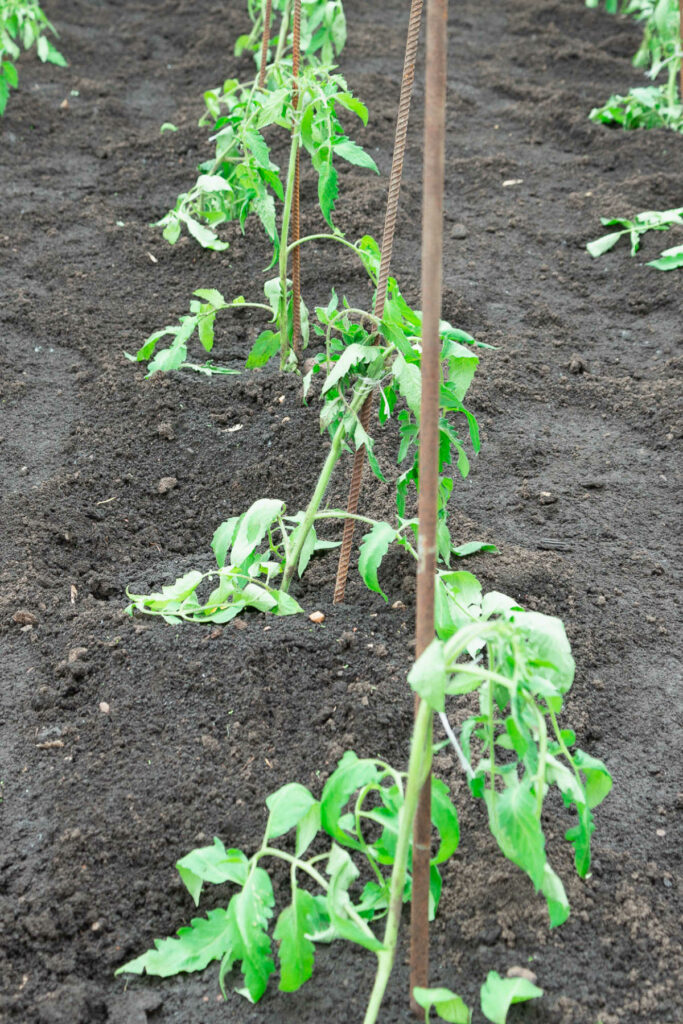
We often make one easily remedied mistake when transplanting our seedlings: Not hardening them off prior to transplanting.
This process is very easy to do. All you need to do is take your seedlings outdoors and expose them to the elements for 7-10 days before transplanting.
You’ll want to start them out for 15-30 minutes in a shady spot with little wind, then each day increase the time, exposure to sun and wind, and bring them back in until you are sure they have acclimated to being outdoors, then you can transplant.
If this is not done properly, you can cause your tomato plant or any other plants to go into shock. This can lead to the leaves of your plant curling and turning yellow and even dying off.
You also still need to be careful if you’re transplanting your older tomatoes to a new pot or bigger container when they are no longer seedlings.
This is because if the roots are disturbed in any way, the leaves can curl and turn yellow. So keep in mind to handle the root ball with care, especially for tomatoes; their roots are extra sensitive.
The only treatment for this is to let your tomato plants be while providing them with enough water. After a few weeks of leaving them alone, your plant should be back to normal. This also should not alter fruit production.
Improper Watering
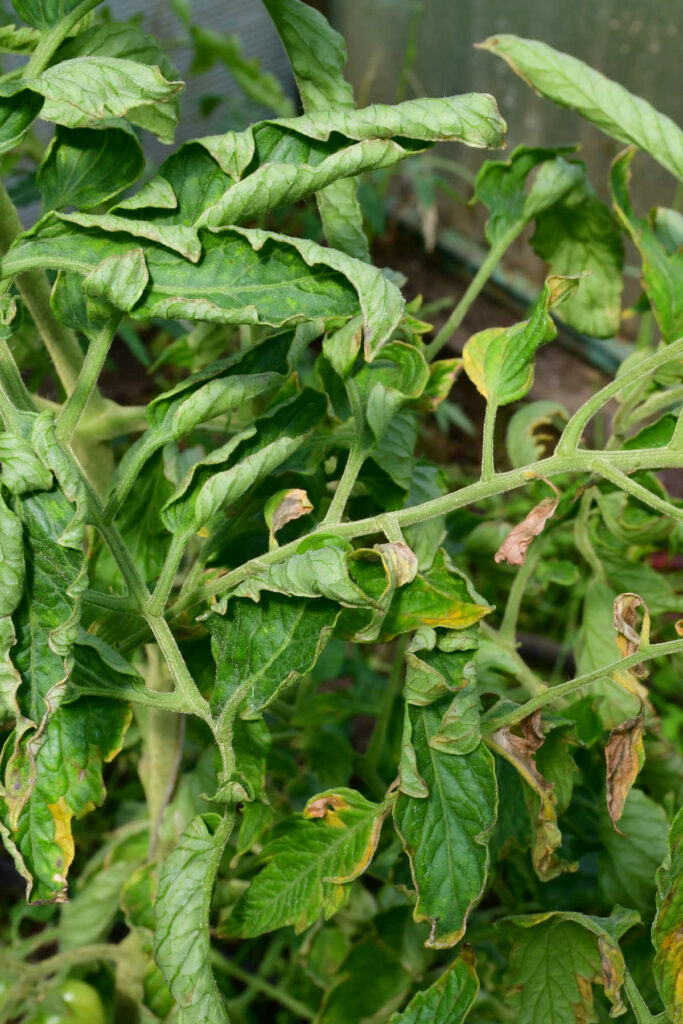
Improper watering can cause any plant to react poorly, but tomatoes seem to be extra fussy about their water uptake.
By watering too little, you stop the plant from thriving, and by watering too much, you damage its fragile roots and uneven watering can cause your fruit to split. All of these can also result in yellow curling leaves.
The treatment for this is quite simple if your tomato plant has too much water, you could wait a few days before watering again. If the soil still seems overly damp, wait another day.
And if you are underwatering, you can bring your plant back to life by supplying 1 inch of water a week. Shortly after you fix how you water, your tomatoes should be back to normal.
To prevent this from happening, be sure when watering that you run the water over the soil and not over the plant. This is because if the leaves of your tomato plant become overly wet, they are more prone to fungus and scorched leaves.
Another thing you want to remember is to keep the soil moist but not overly wet. There should never be standing water. Using a self-watering planter or a watering gauge can help prevent poor watering.
Diseases
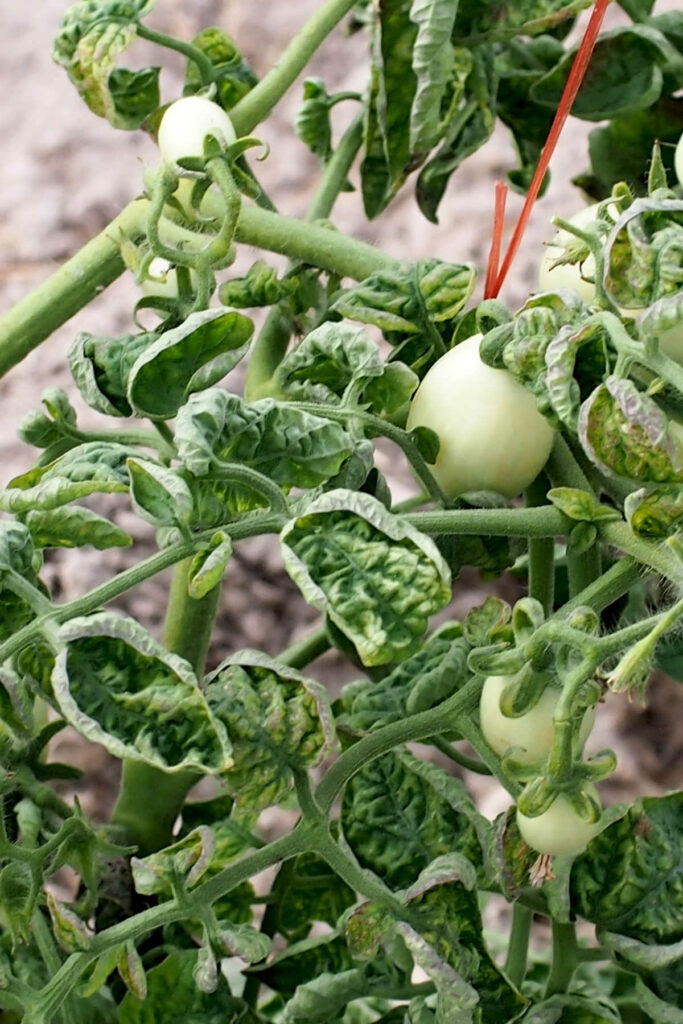
Another reason your tomato leaves are curling is that they have been infected with a disease or virus.
Now even though this can cause your leaves to curl, it’s not the most common cause of tomato leaf curling.
Your tomatoes are more prone to heat exhaustion or poor watering.
However, there are a few viruses that can have the same symptoms. These include:
- Tomato yellow leaf curl
- Tomato mosaic virus
- Curly Top Virus
The symptoms for most of these are the same, the leaves will wilt up or shrink in size and turn yellow, the fruit production is poor or even stunted, and of course, the leaves are curling.
There is no cure for these diseases since they can spread to other parts of the plant and even worse to other plants.
The best course of action is to dispose of the plant properly. Do not compost it. I can not stress this enough. If you were to compost it, any compost you use could infect your garden.
The good news is there are many ways to prevent your tomatoes from getting these diseases.
The most common method is to watch out for whiteflies, aphids, and leafhoppers.
The reason you want to watch out for these pests is that whiteflies can spread yellow leaf curl to tomato plants, leafhoppers can spread the curly top virus to your plants, and lastly, aphids can infect your tomatoes with mosaic virus.
You need to act fast, too, as soon as you spot one of these pests in your garden. Luckily, there are many treatments out there for these unwanted insects.
Too Much Nitrogen
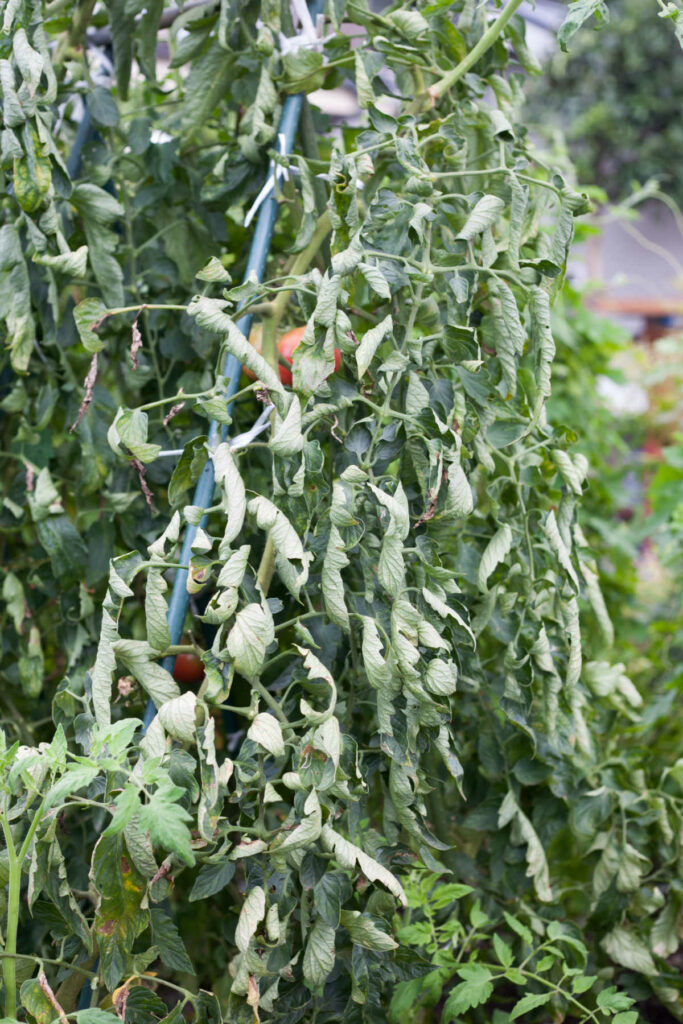
When you use the wrong fertilizer at the wrong time, it can cause the soil to be too high in nitrogen for your tomatoes which then will lead to curling.
This is a common mistake among gardeners, especially beginners.
To prevent this, you need to use a balanced fertilizer when planting, but once your tomato plant starts to bloom, a fertilizer higher in phosphorus and potassium is required.
This is because if your tomatoes receive too much nitrogen at this stage, it will cause the plant to focus on foliage instead of fruit. Tomatoes don’t respond well to this.
There is no treatment for this. The only thing you can do is prevent it from happening; however, if you do make this mistake, just wait it out.
Thrips
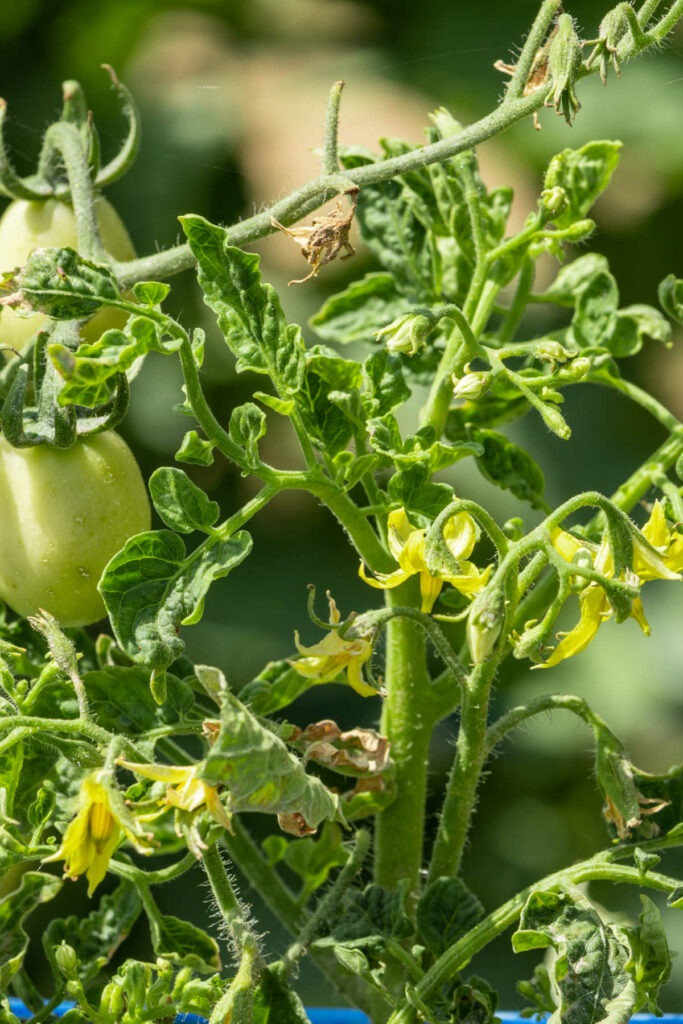
Thrips are another reason your tomato leaves might curl.
Thrips are tiny insects with long, fringed wings that can damage tomato plants by feeding on their leaves. You’ll often find them hiding on the undersides of the leaves.
One way to get rid of thrips is to make up a concoction of soap and water. Add 1 liter of water and 1 teaspoon of mild liquid soap to a spray bottle. Spray this on the leaves that have the thrips on them.
Final Thoughts on Why Tomato Leaves are Curling
Curling tomato leaves can be caused by a variety of factors. Identifying the underlying cause of leaf curl is crucial for implementing an effective solution.
By being vigilant and taking proactive measures to prevent and treat leaf curl, gardeners can help their tomato plants thrive and produce a bountiful harvest.
